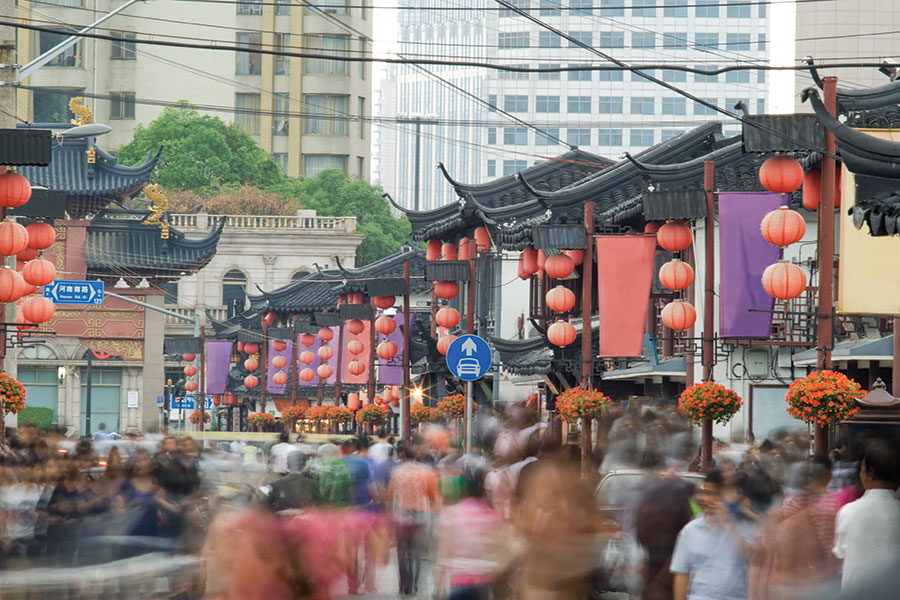Special Report: China’s Gordian Knot
• 12 min read
- Brief: Global Economy

Get the latest in Research & Insights
Sign up to receive a weekly email summary of new articles posted to AMG Research & Insights.

“Only when the world is good, China is good. Only when China is good, can the world get better.”
— Xi Jinping, president, People’s Republic of China
Xi’s message is a sobering reminder of China’s economic ascension.
China is still booming, an astonishing 40-year rise from an impoverished nation to the world’s second largest economy. And its success could possibly make the world a better place. For example, China buys vast quantities of raw materials from other countries to fuel its manufacturing engine, and in return, consumers everywhere enjoy products famously labeled “Made in China.” Since the 2008 financial crisis, China also has been a driving force in worldwide recovery and growth.
The world’s reliance on China is deepening. But daunting, complex economic challenges loom for this nation of 1.4 billion people. It’s a Gordian knot1 that could affect us all.
China is attempting to evolve from a middle-income to an upper-income economy. To avoid the middle-income trap so many other Asian countries have encountered, China’s gross domestic product (GDP) must grow annually at a rate no less than 5%. Considering China’s annual growth averaged over 9% for the past three decades, one would think 5% would be easy. However, that is not the case.
China has resource deficiencies and demographic issues, so it must aggressively look beyond its borders to surmount these obstacles and meet growth objectives. China’s answer: the Belt and Road Initiative (BRI).
The BRI is Xi’s vision for a “New Silk Road” of economic development and Chinese investments across Eurasia, Africa and Latin America. Since announcing the BRI in 2013, China has been building an infrastructure network connecting the communist country to the world. The plan includes constructing:
- Intercontinental highway and rail systems traversing parts of the globe where donkeys, camels and four-wheel vehicles now deliver commerce.
- Oil and natural gas pipelines bringing energy to resource-deficient China.
- Seaports opening underdeveloped countries to resource development and providing the rapidly growing Chinese navy with safe harbors from which it can protect sea lanes critical to China’s economic wellbeing.
- New centers of commerce complete with power, water and sewer plants, and airports to open up international travel.
All these projects will be built by mostly Chinese state-owned enterprises (SOEs) with Chinese materials, labor and expertise. These improvements would bolster the economic wellbeing of local residents while promoting consumption of Chinese products.
If all this can be accomplished, the Gordian knot will be solved, and China likely will surpass the United States as the world’s leading economy by 2050. But under closer examination, the knot isn’t so easily unraveled. In this publication, we explore various economic problems restricting future Chinese growth.

GROWTH REQUIRES SECURE ENERGY RESOURCES
To fuel its growing economy, China currently consumes about 13 million barrels of oil per day (mmb/d).2 Only 4.8 mmb/d3 is produced in China while the rest must be imported mainly from Russia, the Middle East and Africa. That means China transports more than 60% of its energy across maritime routes. Most of these imports pass through the narrowest chokepoints in the world, the Strait of Hormuz (21 miles wide) in the Persian Gulf and the Strait of Malacca (40 miles wide) in Southeast Asia.
These vital sea lanes are a major concern for China’s economic security. The routes are susceptible to wars, natural disasters, piracy and terrorism. If a conflict arose and China was involved, it would be susceptible to having its energy resources cut off. The BRI is part of the answer for resolving this potential problem
GROWTH REQUIRES POPULATION GROWTH
China has the largest population in the world. Almost 50 years ago, China’s population was ballooning with 5.8 births per family.4 With the initiation of a “one-child” policy in 1979, that number has deflated to about 1.6 today,5 which means the Chinese population will soon start shrinking.
Without robust population growth, potential GDP is limited. It’s basic economics: Potential GDP = Population Growth + Productivity Growth. Population growth will eventually be zero and then become negative. When that occurs, productivity growth would need to be at least 5% or higher for China to meet its economic growth objectives. Once again, the BRI may be part of the answer.
GROWTH REQUIRES AGRICULTURAL PRODUCTS
The Chinese are rapidly urbanizing and becoming more prosperous, so they want a more protein- and dairy-based diet. In response to its developing palate, China has become the world’s largest importer of pork, chicken and soybeans. Beijing recently lifted a more than four-year-old ban on U.S. poultry imports, and rising milk prices around the world are partly driven by Chinese demand. Chinese people are consuming more meat, drinking more milk and adding cheese to everyday foods. Cheese-filled spring rolls and tea topped with cream are only the beginning of China’s evolving cuisine.
But China does not have enough water and land to produce all the agricultural products desired by its growing middle class of over 400 million.6 Per capita water resources are about one-fourth the world average, and China is almost out of land used to grow crops due to industrialization, infrastructure construction and land degradation.7 The BRI effort could help developing countries become more stable sources of food for China. By doing so, China could sustain its growing appetite.
GROWTH REQUIRES NATURAL RESOURCES
China has the largest steel-manufacturing industry in the world. Its aluminum production and concrete-making capabilities also are extensive. As a result, China is the world’s largest importer of iron ore, alumina, copper and phosphate. Even though they have large coal mines supplying their power plants, the Chinese consume more coal than they produce.
These large state-owned industries have built China’s impressive infrastructure of highways, dams, high-speed trains and high-tech seaports over the last 20 years. But now China has a problem. It has massive excess capacity in its industrial sectors—especially, steel, glass, aluminum and concrete. Beijing must keep these SOEs afloat or else large parts of the Chinese labor force will be unemployed. Once again, the BRI could be part of the solution in keeping these facilities operating by assuring they have projects around the world to supply.
GROWTH REQUIRES FULL EMPLOYMENT
Full employment means China’s economy is at maximum efficiency. Those who should be working are working. A strong labor force means Chinese people are happy and more willing to spend. China’s domestic consumption contributes to almost 40% of GDP, whereas in the U.S.,8 it accounts for almost 70%.9 Beijing is keenly concerned about growing unemployment and angry citizens.
China’s officially reported unemployment rate is 3.61%.10 However, its real unemployment rate is much higher and causing uneven growth.11 Comparable in population, the coastal metropolis of Shanghai is five times wealthier than the inland province of Gansu.12 The rich are getting richer as the poor are staying poor, thus future growth will rely heavily on inland development of workers’ skills and economic development. Without this there would be growing social unrest and wavering emotions toward the Communist Party of China (CPC). That would be a formula for a doomed Chinese command-economy. The BRI offers a solution for underemployment and regional employment disparities.
GROWTH REQUIRES VALUE-ADDED PRODUCTS
China wants to upgrade its economy through value-added products. From semiconductors to artificial intelligence, China is shifting its economy to high-quality and innovation-driven growth. Beijing is upgrading its industry by exporting Chinese technology and engineering expertise around the world. Look at tech giants, Huawei and Alibaba.
Huawei is leading the future with its end-to-end 5G capabilities. It is already the largest supplier of state surveillance systems and mobile internet networks in Africa.13 Huawei and Alibaba unveiled their first artificial intelligence (AI) chips this year. Alibaba’s chip, Hanguang 800, is said to cut computing tasks of a performing machine down from an hour to five minutes.14
The Chinese tech giants’ rise in the global tech industry is all thanks to Made in China 2025 (MIC2025). Through government subsidies and forced technology transfers from Western corporations, this reform will help China achieve 70% self-sufficiency in 10 high-tech sectors by 2025 (e.g. next-generation IT, aerospace and aviation equipment, advanced rail equipment, high-end numerical control machinery and robotics)15 and become the dominant industry in global technology markets by 2049.16
Thus innovation, research and education will continue to be vital to China’s long-term development and modernization. However, China needs to stimulate global demand for its high value-added products. The BRI may open markets for these products.
GROWTH REQUIRES PRODUCTIVITY GAINS
China has been the “world’s factory.” China’s resource-intensive economy was built from low-cost exports of mobile phones, computers, air-conditioners and televisions. Its manufacturing industry grew from 3% of the global market to about 50% in under 30 years.17 However, being the world’s factory has its costs. It’s been energy intensive and highly polluting. Now, China is losing its comparative advantage in low-value manufacturing as wages rise. China wants to change.
Remembering the basic economic formula from before, China plans to achieve its 5% productivity growth by shifting its focus from quantity to quality. It hopes to make its declining population more productive and innovative. The BRI may help make this happen.
GROWTH REQUIRES SUCCESSFUL EXPORTING
China is the world’s largest exporter. Exports account for almost 20% of China’s GDP.18 Beijing’s top trading partners span North America, Asia and Europe. Soaring international consumer demand has been an important driver of China’s growth since 1990. As a result, China must export its goods across the world using different modes of transportation.
China’s main mode of international transportation is the sea. This is because the other modes—roads and rail—are still underdeveloped. There aren’t any roads or railways connecting China to its trading partners. Crossing borders through poor infrastructure, corrupt governments and nations plagued by wars is costly and dangerous. The future of China’s successful export industries is tied to securing borders and trade interconnectivity. Enter the BRI.
Conclusion
The BRI has been underway for six years now. It can be defined as this century’s Marshall Plan—the U.S.-led initiative that rebuilt Western Europe after World War II. However, the BRI is much greater in terms of scale and the amount of investments. China has already financed nearly 14,000 19 BRI infrastructure projects worth $400-$700 billion, but it’s not stopping there. Beijing plans to invest at least $4 trillion into the BRI by 2049. With the number of nations participating in the BRI growing every year, Xi formally added the strategy to the communist party’s constitution in 2017.20
The BRI is altering the global economy in order to resolve China’s Gordian knot. If successful, China’s BRI will have a significant impact on the economic development of Asia, Europe, the Middle East, Africa and Latin America. This makes us wonder if there will be any opportunities for the rest of the developed world if this becomes an intentionally closed Chinese system.
But like any grand plan, execution is the key. If it fails, China may not be able to resolve its Gordian knot let alone become the world’s greatest economic power. In future AMG white papers, we will examine the importance of energy, the execution challenges and where corporate America fits into the BRI, if at all.
Notes
-
Gordian knot is in reference to an ancient expression for a complex problem.
-
What Countries Are the Top Producers and Consumers of Oil? U.S. Energy Information Administration, Nov. 2019, eia.gov/tools/faqs/faq.php?id=709A&t=6.
-
What Countries Are the Top Producers and Consumers of Oil? U.S. Energy Information Administration, Nov. 2019, eia.gov/tools/faqs/faq.php?id=709A&t=6.
-
Peng, Xizhe. “China’s Demographic History and Future Challenges.” Science, 2011, pp. 581-587, https://www.researchgate.net/profile/Xizhe_Peng/publication/51530365_ China%27s_Demographic_History_and_Future_Challenges/links/559f59c208aeffab5687e54f.pdf.
-
Kuo, Lily and Xueying Wang. Can China Recover from its Disastrous One-child Policy?. The Guardian, 2 Mar. 2019, https://www.theguardian.com/world/2019/mar/02/chinapopulation-control-two-child-policy.
-
How Well-off is China’s Middle Class? China Power, Center for Strategic & International Studies, 29 May 2019, https://chinapower.csis.org/china-middle-class/.
-
Peng, Xizhe. “China’s Demographic History and Future Challenges.” Science, 2011, pp. 581-587, https://www.researchgate.net/profile/Xizhe_Peng/publication/51530365_ China%27s_Demographic_History_and_Future_Challenges/links/559f59c208aeffab5687e54f.pdf.
-
China Private Consumption: % of GDP. CEIC, https://www.ceicdata.com/en/indicator/china/private-consumption–of-nominal-gdp.
-
United States Private Consumption: % of GDP. CEIC, https://www.ceicdata.com/en/indicator/united-states/private-consumption–of-nominal-gdp.
-
China Unemployment Rate. Trading Economics, https://tradingeconomics.com/china/unemployment-rate.
-
Skepticism about official Chinese data has been apparent for years. In order to build credibility, local Chinese governments will use the same measuring techniques as the national statistics bureau. Source: Qi, Liyan. Beijing’s Latest Effort to Get Its Numbers Taken Seriously. The Wall Street Journal, 14 Nov. 2019, https://www.wsj.com/articles/beijings-latest-effort-to-get-its-numbers-taken-seriously-11573728286.
-
Cai, Peter. “Understanding China’s Belt and Road Initiative.” Lowy Institute for International Policy, Mar. 2017, pp. 1-22, https://think-asia.org/bitstream/handle/11540/6810/ Understanding_Chinas_Belt_and_Road_Initiative_WEB_1.pdf?sequence=1
-
Parkinson, Joe, Bariyo, Nicholas, and Josh Chin. Huawei Technicians Helped African Governments Spy on Political Opponents. The Wall Street Journal, 15 Aug. 2019, https://www. wsj.com/articles/huawei-technicians-helped-african-governments-spy-on-political-opponents-11565793017?mod=hp_lead_pos4.
-
Kharpal, Arjun. Alibaba unveils its first A.I. chip as China pushes for its own semiconductor technology. CNBC, 25 Sep. 2019, https://www.cnbc.com/2019/09/25/alibaba-unveils-its-first-ai-chip-called-the-hanguang-800.html.
-
China Manufacturing 2025: Putting Industrial Policy Ahead of Market Forces. European Chamber, 2017, http://docs.dpaq.de/12007-european_chamber_cm2025-en.pdf.
-
McBride, James and Andrew Chatzky. Is ‘Made in China 2025’ a Threat to Global Trade? Council on Foreign Relations, 13 May 2019, https://www.cfr.org/backgrounder/made-china-2025-threat-global-trade.
-
Xiao, Maya. China’s Manufacturing Industry in 2018. Interact Analysis, https://www.interactanalysis.com/chinas-manufacturing-industry-in-2018/.
-
China- Exports of Goods and Services (% of GDP). Trading Economics, https://tradingeconomics.com/china/exports-of-goods-and-services-percent-of-gdp-wb-data.html.
-
Reconnecting Asia. Center for Strategic & International Studies, 2019, https://reconnectingasia.csis.org/map/.
-
Hurley, John, Morris, Scott, and Gailyn Portelance. “Examining the Debt Implications of the Belt and Road Initiative from a Policy Perspective.” Journal of Infrastructure, Policy and Development, vol. 3, no. 1, 2019, pp.139-175, https://systems.enpress-publisher.com/index.php/jipd/article/viewFile/1123/871.
This information is for general information use only. It is not tailored to any specific situation, is not intended to be investment, tax, financial, legal, or other advice and should not be relied on as such. AMG’s opinions are subject to change without notice, and this report may not be updated to reflect changes in opinion. Forecasts, estimates, and certain other information contained herein are based on proprietary research and should not be considered investment advice or a recommendation to buy, sell or hold any particular security, strategy, or investment product.
Get the latest in Research & Insights
Sign up to receive a weekly email summary of new articles posted to AMG Research & Insights.





